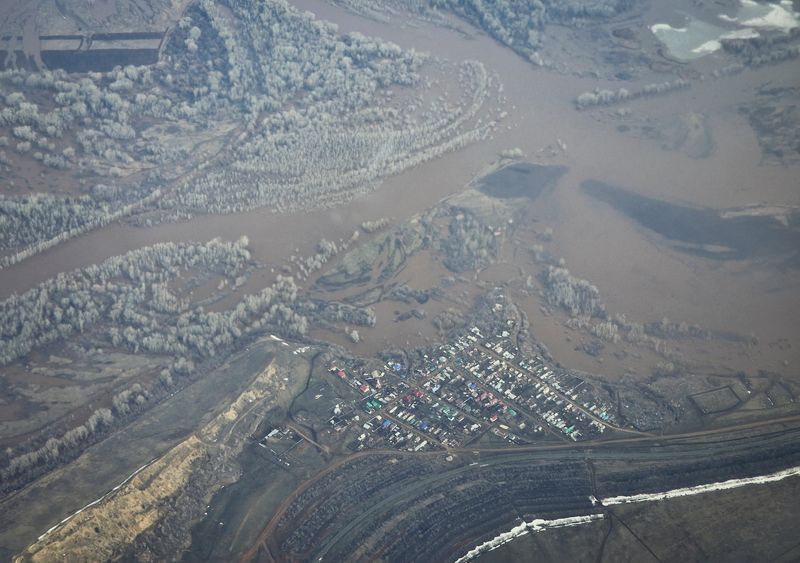By Guy Faulconbridge and Olzhas Auyezov
MOSCOW/ALMATY (Reuters) – Floods gripped cities and towns across Russia and Kazakhstan on Wednesday after Europe’s third-longest river burst its banks, forcing over 110,000 people to evacuate and swamping parts of the Russian city of Orenburg.
What is happening, where and why?
WHICH AREAS ARE AFFECTED?
The worst hit areas in Russia are just to the south of the Ural Mountains, about 1,200 km (750 miles) east of Moscow. Emergencies have been declared in the Orenburg and Kurgan regions of the Urals and in the Tyumen region of Siberia.
In Kazakhstan, the worst hit areas are Atyrau, Aktobe, Akmola, Kostanai, Eastern Kazakhstan, Northern Kazakhstan and Pavlodar regions, most of which border Russia and are crossed by rivers originating in Russia or flowing from Kazakhstan to Russia.
Major rivers such as the Ural, which rises in the Ural mountains and flows through Kazakhstan into the Caspian Sea, are particular concerns. The Ural burst through embankment dams in the Urals city of Orsk on April 5 and the river has flooded parts of the city of Orenburg.
In Kazakhstan, the Ural flows through the major oil industry hub of Atyrau, where authorities have closed schools and mobilised thousands of people to reinforce river banks and build dams.
There are also concerns about the Tobol and Ishim, tributaries of the Irtysh, which along with its parent, the Ob, forms the world’s seventh longest river system.
Some regions around the Volga, Europe’s longest river, have experienced flooding as has the Altai region of Siberia.
WHAT IS THE HUMAN COST?
– More than 97,000 people evacuated in Kazakhstan
– At least 12,000 people evacuated in Russia
– Around 10,500 homes recorded as flooded so far in Russia
– In Kazakhstan, 3,444 homes reported to remain flooded
– Russia has stepped up bottled water supplies. Hepatitis A vaccinations were being conducted in flooded areas
WHAT ARE THE ECONOMIC RISKS?
– Billions of dollars worth of property has been destroyed
– Some of the areas experiencing floods are also key wheat producing areas. Russia is the world’s biggest wheat exporter.
– Western Siberia is the largest hydrocarbon basin in the world. Russia is the world’s second largest oil exporter.
– Russia’s Orsk oil refinery declared force majeure on fuel supply from April 8, according to a document issued by plant owner Forteinvest and seen by Reuters.
It said the plant had been shut to avoid ecological risks and ensure labour safety. Last year the refinery processed 4.5 million metric tons (90,000 barrels per day) of oil.
– Over 8,000 farm animals have been killed by floods in Kazakhstan, and a special squad has been deployed by the agriculture ministry to dispose of the bodies and prevent the spread of diseases.
WHAT IS THE CAUSE OF THE FLOODS?
Spring flooding is a usual part of life across Russia as the harsh winter snows melt, swelling some of the mighty rivers of Russia and Central Asia. This year, though, a combination of factors triggered unusually severe flooding.
Russian emergency officials said the soil was waterlogged before winter and then was frozen under very high snow falls which then melted very fast in swiftly rising spring temperatures and heavy rains.
One Russian official, the Presidential Plenipotentiary in the Urals Region, Vladimir Yakushev, was quoted by Russian media as suggesting that Kazakhstan was to blame for not coordinating the discharge of water more effectively.
CLIMATE CHANGE?
It is not immediately clear if climate change could be affecting the situation.
Russia is by far the world’s biggest country by land area – about the size of the United States and Australia together. Russia’s boreal forests, or taiga, cover an area about equal to the United States and are the largest forested areas on earth so play a crucial role in the world’s climate.
In 2009 research commissioned by the U.S. National Intelligence Council on the impact of climate change on Russia to 2030, the authors said the rise in temperatures would lead to a series of complex issues for Russia.
Among them were the increased frequency of extreme climatic events including heavy rains, fires in Siberian peatlands and more frequent flooding of Russia’s Arctic rivers due to heavy rain and earlier breakup of river ice.
The paper stated that by 2015, there would likely be more flooding in river basins of the Archangelsk Region, the Komi Republic, the Ural area, and in the basins of Yenisei and Lena.
